
linkedin-api
👨💼 LinkedIn API for Python
Stars: 1842

The Linkedin API for Python allows users to programmatically search profiles, send messages, and find jobs using a regular Linkedin user account. It does not require 'official' API access, just a valid Linkedin account. However, it is important to note that this library is not officially supported by LinkedIn and using it may violate LinkedIn's Terms of Service. Users can authenticate using any Linkedin account credentials and access features like getting profiles, profile contact info, and connections. The library also provides commercial alternatives for extracting data, scraping public profiles, and accessing a full LinkedIn API. It is not endorsed or supported by LinkedIn and is intended for educational purposes and personal use only.
README:
Search profiles, send messages, find jobs and more in Python. No official API access required.
- ✅ No official API access required. Just use a valid LinkedIn user account.
- ✅ Direct HTTP API interface. No Selenium, Pupeteer, or other browser-based scraping methods.
- ✅ Get and search people, companies, jobs, posts
- ✅ Send and retrieve messages
- ✅ Send and accept connection requests
- ✅ Get and react to posts
And more! Read the docs for all API methods.
[!IMPORTANT] This library is not officially supported by LinkedIn. Using this library might violate LinkedIn's Terms of Service. Use it at your own risk.
[!NOTE] Python >= 3.10 required
pip install linkedin-apiOr, for bleading edge:
pip install git+https://github.com/tomquirk/linkedin-api.git[!TIP] See all API methods on the docs.
The following snippet demonstrates a few basic linkedin_api use cases:
from linkedin_api import Linkedin
# Authenticate using any Linkedin user account credentials
api = Linkedin('[email protected]', '*******')
# GET a profile
profile = api.get_profile('billy-g')
# GET a profiles contact info
contact_info = api.get_profile_contact_info('billy-g')
# GET 1st degree connections of a given profile
connections = api.get_profile_connections('1234asc12304')This is a sponsored section
Extract data and find verified emails in real-time with Prospeo LinkedIn Email Finder API.
Learn more
Submit a LinkedIn profile URL to our API and get:- Profile data extracted in real-time
- Company data of the profile
- Verified work email of the profile
- Exclusive data points (gender, cleaned country code, time zone...)
- One do-it-all request
- Stable API, tested under high load
Try it with 75 profiles. Get your FREE API key now.
Scrape public LinkedIn profile data at scale with Proxycurl APIs.
Learn more
- Scraping Public profiles are battle tested in court in HiQ VS LinkedIn case.
- GDPR, CCPA, SOC2 compliant
- High rate limit - 300 requests/minute
- Fast - APIs respond in ~2s
- Fresh data - 88% of data is scraped real-time, other 12% are not older than 29 days
- High accuracy
- Tons of data points returned per profile
Built for developers, by developers.
Full LinkedIn API: Connect Classic/Sales Navigator/Recruiter, synchronize real-time messaging, enrich data and build outreach sequences…
Learn more
- Easily connect your users in the cloud with our white-label authentication (captcha solving, in-app validation, OTP, 2FA).
- Real-time webhook for each message received, read status, invitation accepted, and more.
- Data extraction: get profile, get company, get post, extract search results from Classic + Sales Navigator + Recruiter
- Outreach sequences: send invitations, InMail, messages, and comment on posts…
Test all the features with our 7-day free trial.
Scrape Any Data from LinkedIn, without limit with ScrapIn API.
Learn more
- Real time data (no-cache)
- Built for SaaS developers
- GDPR, CCPA, SOC2 compliant
- Interactive API documentation
- A highly stable API, backed by over 4 years of experience in data provisioning, with the added reliability of two additional data provider brands owned by the company behind ScrapIn.
Try it for free. Get your API key now
Access high-quality, real-time LinkedIn data at scale with iScraper API, offering unlimited scalability and unmatched accuracy.
Learn more
- Real-time LinkedIn data scraping with unmatched accuracy
- Hosted datasets with powerful Lucene search access
- Designed for enterprise and corporate-level applications
- Handles millions of scrapes per day, ensuring unlimited scalability
- Trusted by top enterprises for mission-critical data needs
- Interactive API documentation built on OpenAPI 3 specs for seamless integration
- Backed by over 10 years of experience in real-time data provisioning
- Lowest price guarantee for high volume use
Get started here.
End sponsored section
poetry- A valid Linkedin user account (don't use your personal account, if possible)
-
Create a
.envconfig file (use.env.exampleas a reference) -
Install dependencies using
poetry:poetry install
Run all tests:
poetry run pytestRun unit tests:
poetry run pytest tests/unitRun E2E tests:
poetry run pytest tests/e2epoetry run black --check .Or to fix:
poetry run black .Linkedin will throw you a curve ball in the form of a Challenge URL. We currently don't handle this, and so you're kinda screwed. We think it could be only IP-based (i.e. logging in from different location). Your best chance at resolution is to log out and log back in on your browser.
Known reasons for Challenge include:
- 2FA
- Rate-limit - "It looks like you’re visiting a very high number of pages on LinkedIn.". Note - n=1 experiment where this page was hit after ~900 contiguous requests in a single session (within the hour) (these included random delays between each request), as well as a bunch of testing, so who knows the actual limit.
Please add more as you come across them.
- Mileage may vary when searching general keywords like "software" using the standard
searchmethod. They've recently added some smarts around search whereby they group results by people, company, jobs etc. if the query is general enough. Try to use an entity-specific search method (i.e. search_people) where possible.
This project attempts to provide a simple Python interface for the LinkedIn API.
Do you mean the legit LinkedIn API?
NO! To retrieve structured data, the LinkedIn Website uses a service they call Voyager. Voyager endpoints give us access to pretty much everything we could want from LinkedIn: profiles, companies, connections, messages, etc. - anything that you can see on linkedin.com, we can get from Voyager.
This project aims to provide complete coverage for Voyager.
Voyager endpoints look like this:
https://www.linkedin.com/voyager/api/identity/profileView/tom-quirk
Or, more clearly
___________________________________ _______________________________
| base path | resource |
https://www.linkedin.com/voyager/api /identity/profileView/tom-quirk
They are authenticated with a simple cookie, which we send with every request, along with a bunch of headers.
To get a cookie, we POST a given username and password (of a valid LinkedIn user account) to https://www.linkedin.com/uas/authenticate.
We're looking at the LinkedIn website and we spot some data we want. What now?
The following describes the most reliable method to find relevant endpoints:
-
view source -
command-f/search the page for some keyword in the data. This will exist inside of a<code>tag. -
Scroll down to the next adjacent element which will be another
<code>tag, probably with anidthat looks something like<code style="display: none" id="datalet-bpr-guid-3900675"> {"request":"/voyager/api/identity/profiles/tom-quirk/profileView","status":200,"body":"bpr-guid-3900675"} </code>
The value of request is the url! 🤘
You can also use the network tab in you browsers developer tools, but you will encounter mixed results.
linkedin.com uses the Rest-li Protocol for querying data. Rest-li is an internal query language/syntax where clients (like linkedin.com) specify what data they want. It's conceptually similar to the GraphQL.
Here's an example of making a request for an organisation's name and groups (the Linkedin groups it manages):
/voyager/api/organization/companies?decoration=(name,groups*~(entityUrn,largeLogo,groupName,memberCount,websiteUrl,url))&q=universalName&universalName=linkedin
The "querying" happens in the decoration parameter, which looks like the following:
(
name,
groups*~(entityUrn,largeLogo,groupName,memberCount,websiteUrl,url)
)
Here, we request an organisation name and a list of groups, where for each group we want largeLogo, groupName, and so on.
Different endpoints use different parameters (and perhaps even different syntaxes) to specify these queries. Notice that the above query had a parameter q whose value was universalName; the query was then specified with the decoration parameter.
In contrast, the /search/cluster endpoint uses q=guided, and specifies its query with the guided parameter, whose value is something like
List(v->PEOPLE)
It could be possible to document (and implement a nice interface for) this query language - as we add more endpoints to this project, I'm sure it will become more clear if such a thing would be possible (and if it's worth it).
- Bump
versioninpyproject.toml poetry buildpoetry publish- Draft release notes in GitHub.
This library is not endorsed or supported by LinkedIn. It is an unofficial library intended for educational purposes and personal use only. By using this library, you agree to not hold the author or contributors responsible for any consequences resulting from its usage.
For Tasks:
Click tags to check more tools for each tasksFor Jobs:
Alternative AI tools for linkedin-api
Similar Open Source Tools

linkedin-api
The Linkedin API for Python allows users to programmatically search profiles, send messages, and find jobs using a regular Linkedin user account. It does not require 'official' API access, just a valid Linkedin account. However, it is important to note that this library is not officially supported by LinkedIn and using it may violate LinkedIn's Terms of Service. Users can authenticate using any Linkedin account credentials and access features like getting profiles, profile contact info, and connections. The library also provides commercial alternatives for extracting data, scraping public profiles, and accessing a full LinkedIn API. It is not endorsed or supported by LinkedIn and is intended for educational purposes and personal use only.

bia-bob
BIA `bob` is a Jupyter-based assistant for interacting with data using large language models to generate Python code. It can utilize OpenAI's chatGPT, Google's Gemini, Helmholtz' blablador, and Ollama. Users need respective accounts to access these services. Bob can assist in code generation, bug fixing, code documentation, GPU-acceleration, and offers a no-code custom Jupyter Kernel. It provides example notebooks for various tasks like bio-image analysis, model selection, and bug fixing. Installation is recommended via conda/mamba environment. Custom endpoints like blablador and ollama can be used. Google Cloud AI API integration is also supported. The tool is extensible for Python libraries to enhance Bob's functionality.

datalore-localgen-cli
Datalore is a terminal tool for generating structured datasets from local files like PDFs, Word docs, images, and text. It extracts content, uses semantic search to understand context, applies instructions through a generated schema, and outputs clean, structured data. Perfect for converting raw or unstructured local documents into ready-to-use datasets for training, analysis, or experimentation, all without manual formatting.

browser
Lightpanda Browser is an open-source headless browser designed for fast web automation, AI agents, LLM training, scraping, and testing. It features ultra-low memory footprint, exceptionally fast execution, and compatibility with Playwright and Puppeteer through CDP. Built for performance, Lightpanda offers Javascript execution, support for Web APIs, and is optimized for minimal memory usage. It is a modern solution for web scraping and automation tasks, providing a lightweight alternative to traditional browsers like Chrome.

neural
Neural is a Vim and Neovim plugin that integrates various machine learning tools to assist users in writing code, generating text, and explaining code or paragraphs. It supports multiple machine learning models, focuses on privacy, and is compatible with Vim 8.0+ and Neovim 0.8+. Users can easily configure Neural to interact with third-party machine learning tools, such as OpenAI, to enhance code generation and completion. The plugin also provides commands like `:NeuralExplain` to explain code or text and `:NeuralStop` to stop Neural from working. Neural is maintained by the Dense Analysis team and comes with a disclaimer about sending input data to third-party servers for machine learning queries.

metavoice-src
MetaVoice-1B is a 1.2B parameter base model trained on 100K hours of speech for TTS (text-to-speech). It has been built with the following priorities: * Emotional speech rhythm and tone in English. * Zero-shot cloning for American & British voices, with 30s reference audio. * Support for (cross-lingual) voice cloning with finetuning. * We have had success with as little as 1 minute training data for Indian speakers. * Synthesis of arbitrary length text

lhotse
Lhotse is a Python library designed to make speech and audio data preparation flexible and accessible. It aims to attract a wider community to speech processing tasks by providing a Python-centric design and an expressive command-line interface. Lhotse offers standard data preparation recipes, PyTorch Dataset classes for speech tasks, and efficient data preparation for model training with audio cuts. It supports data augmentation, feature extraction, and feature-space cut mixing. The tool extends Kaldi's data preparation recipes with seamless PyTorch integration, human-readable text manifests, and convenient Python classes.
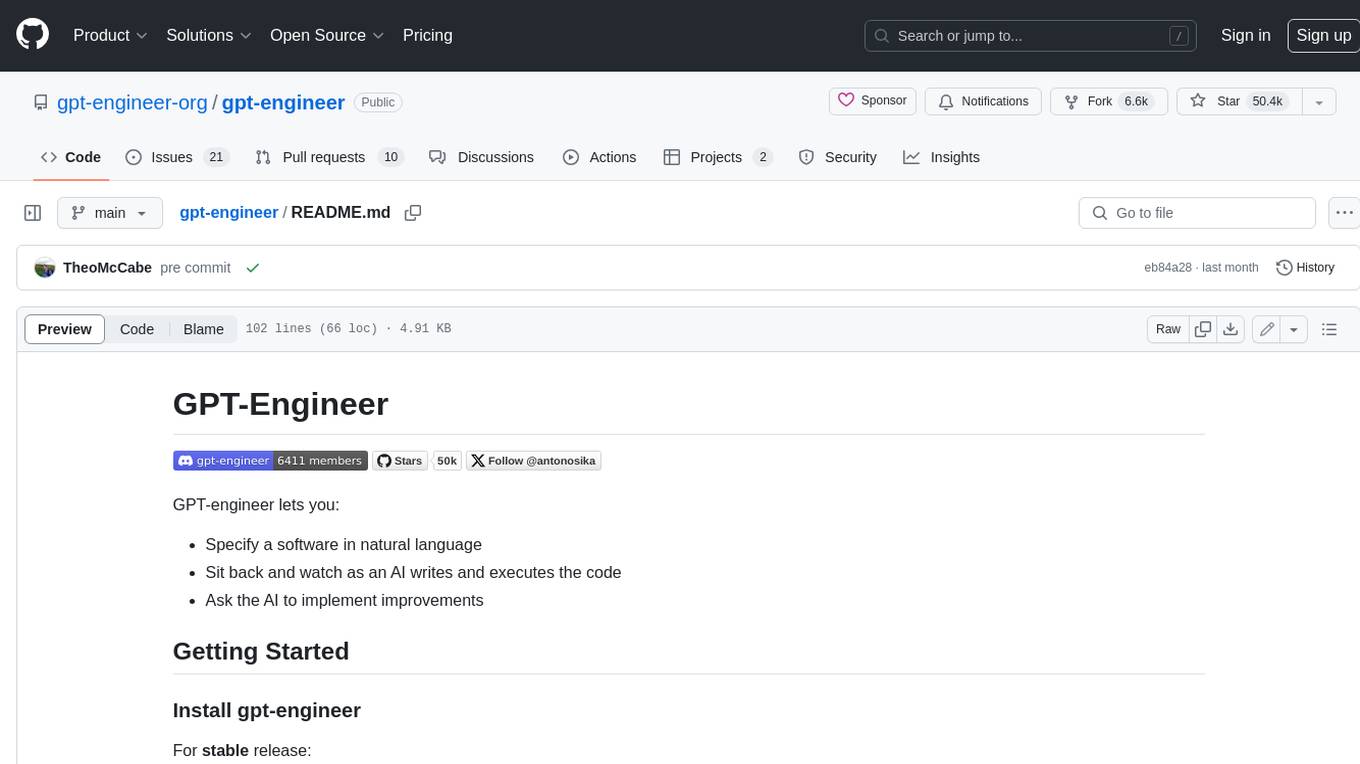
gpt-engineer
GPT-Engineer is a tool that allows you to specify a software in natural language, sit back and watch as an AI writes and executes the code, and ask the AI to implement improvements.

deepeval
DeepEval is a simple-to-use, open-source LLM evaluation framework specialized for unit testing LLM outputs. It incorporates various metrics such as G-Eval, hallucination, answer relevancy, RAGAS, etc., and runs locally on your machine for evaluation. It provides a wide range of ready-to-use evaluation metrics, allows for creating custom metrics, integrates with any CI/CD environment, and enables benchmarking LLMs on popular benchmarks. DeepEval is designed for evaluating RAG and fine-tuning applications, helping users optimize hyperparameters, prevent prompt drifting, and transition from OpenAI to hosting their own Llama2 with confidence.

depthai
This repository contains a demo application for DepthAI, a tool that can load different networks, create pipelines, record video, and more. It provides documentation for installation and usage, including running programs through Docker. Users can explore DepthAI features via command line arguments or a clickable QT interface. Supported models include various AI models for tasks like face detection, human pose estimation, and object detection. The tool collects anonymous usage statistics by default, which can be disabled. Users can report issues to the development team for support and troubleshooting.

obs-cleanstream
CleanStream is an OBS plugin that utilizes AI to clean live audio streams by removing unwanted words and utterances, such as 'uh's and 'um's, and configurable words like profanity. It uses a neural network (OpenAI Whisper) in real-time to predict speech and eliminate unwanted words. The plugin is still experimental and not recommended for live production use, but it is functional for testing purposes. Users can adjust settings and configure the plugin to enhance audio quality during live streams.

guidellm
GuideLLM is a powerful tool for evaluating and optimizing the deployment of large language models (LLMs). By simulating real-world inference workloads, GuideLLM helps users gauge the performance, resource needs, and cost implications of deploying LLMs on various hardware configurations. This approach ensures efficient, scalable, and cost-effective LLM inference serving while maintaining high service quality. Key features include performance evaluation, resource optimization, cost estimation, and scalability testing.

AP2
The Agent Payments Protocol (AP2) repository contains code samples and demos showcasing the protocol. It includes curated scenarios demonstrating key components, utilizing the Agent Development Kit (ADK) and Gemini 2.5 Flash. Users are free to use any tools to build agents. The repository features various agents and servers, with source code located in specific directories. Users can run scenarios by following README instructions and using run scripts. Additionally, the repository provides guidance on setting up prerequisites, obtaining a Google API key, and installing the AP2 types package.

RAVE
RAVE is a variational autoencoder for fast and high-quality neural audio synthesis. It can be used to generate new audio samples from a given dataset, or to modify the style of existing audio samples. RAVE is easy to use and can be trained on a variety of audio datasets. It is also computationally efficient, making it suitable for real-time applications.

autoarena
AutoArena is a tool designed to create leaderboards ranking Language Model outputs against one another using automated judge evaluation. It allows users to rank outputs from different LLMs, RAG setups, and prompts to find the best configuration of their system. Users can perform automated head-to-head evaluation using judges from various platforms like OpenAI, Anthropic, and Cohere. Additionally, users can define and run custom judges, connect to internal services, or implement bespoke logic. AutoArena enables users to run the application locally, providing full control over their environment and data.

obs-cleanstream
CleanStream is an OBS plugin that utilizes real-time local AI to clean live audio streams by removing unwanted words and utterances, such as 'uh' and 'um', and configurable words like profanity. It employs a neural network (OpenAI Whisper) to predict speech in real-time and eliminate undesired words. The plugin runs efficiently using the Whisper.cpp project from ggerganov. CleanStream offers users the ability to adjust settings and add the plugin to any audio-generating source in OBS, providing a seamless experience for content creators looking to enhance the quality of their live audio streams.
For similar tasks

skyvern
Skyvern automates browser-based workflows using LLMs and computer vision. It provides a simple API endpoint to fully automate manual workflows, replacing brittle or unreliable automation solutions. Traditional approaches to browser automations required writing custom scripts for websites, often relying on DOM parsing and XPath-based interactions which would break whenever the website layouts changed. Instead of only relying on code-defined XPath interactions, Skyvern adds computer vision and LLMs to the mix to parse items in the viewport in real-time, create a plan for interaction and interact with them. This approach gives us a few advantages: 1. Skyvern can operate on websites it’s never seen before, as it’s able to map visual elements to actions necessary to complete a workflow, without any customized code 2. Skyvern is resistant to website layout changes, as there are no pre-determined XPaths or other selectors our system is looking for while trying to navigate 3. Skyvern leverages LLMs to reason through interactions to ensure we can cover complex situations. Examples include: 1. If you wanted to get an auto insurance quote from Geico, the answer to a common question “Were you eligible to drive at 18?” could be inferred from the driver receiving their license at age 16 2. If you were doing competitor analysis, it’s understanding that an Arnold Palmer 22 oz can at 7/11 is almost definitely the same product as a 23 oz can at Gopuff (even though the sizes are slightly different, which could be a rounding error!) Want to see examples of Skyvern in action? Jump to #real-world-examples-of- skyvern

airbyte-connectors
This repository contains Airbyte connectors used in Faros and Faros Community Edition platforms as well as Airbyte Connector Development Kit (CDK) for JavaScript/TypeScript.

open-parse
Open Parse is a Python library for visually discerning document layouts and chunking them effectively. It is designed to fill the gap in open-source libraries for handling complex documents. Unlike text splitting, which converts a file to raw text and slices it up, Open Parse visually analyzes documents for superior LLM input. It also supports basic markdown for parsing headings, bold, and italics, and has high-precision table support, extracting tables into clean Markdown formats with accuracy that surpasses traditional tools. Open Parse is extensible, allowing users to easily implement their own post-processing steps. It is also intuitive, with great editor support and completion everywhere, making it easy to use and learn.

unstract
Unstract is a no-code platform that enables users to launch APIs and ETL pipelines to structure unstructured documents. With Unstract, users can go beyond co-pilots by enabling machine-to-machine automation. Unstract's Prompt Studio provides a simple, no-code approach to creating prompts for LLMs, vector databases, embedding models, and text extractors. Users can then configure Prompt Studio projects as API deployments or ETL pipelines to automate critical business processes that involve complex documents. Unstract supports a wide range of LLM providers, vector databases, embeddings, text extractors, ETL sources, and ETL destinations, providing users with the flexibility to choose the best tools for their needs.

Dot
Dot is a standalone, open-source application designed for seamless interaction with documents and files using local LLMs and Retrieval Augmented Generation (RAG). It is inspired by solutions like Nvidia's Chat with RTX, providing a user-friendly interface for those without a programming background. Pre-packaged with Mistral 7B, Dot ensures accessibility and simplicity right out of the box. Dot allows you to load multiple documents into an LLM and interact with them in a fully local environment. Supported document types include PDF, DOCX, PPTX, XLSX, and Markdown. Users can also engage with Big Dot for inquiries not directly related to their documents, similar to interacting with ChatGPT. Built with Electron JS, Dot encapsulates a comprehensive Python environment that includes all necessary libraries. The application leverages libraries such as FAISS for creating local vector stores, Langchain, llama.cpp & Huggingface for setting up conversation chains, and additional tools for document management and interaction.
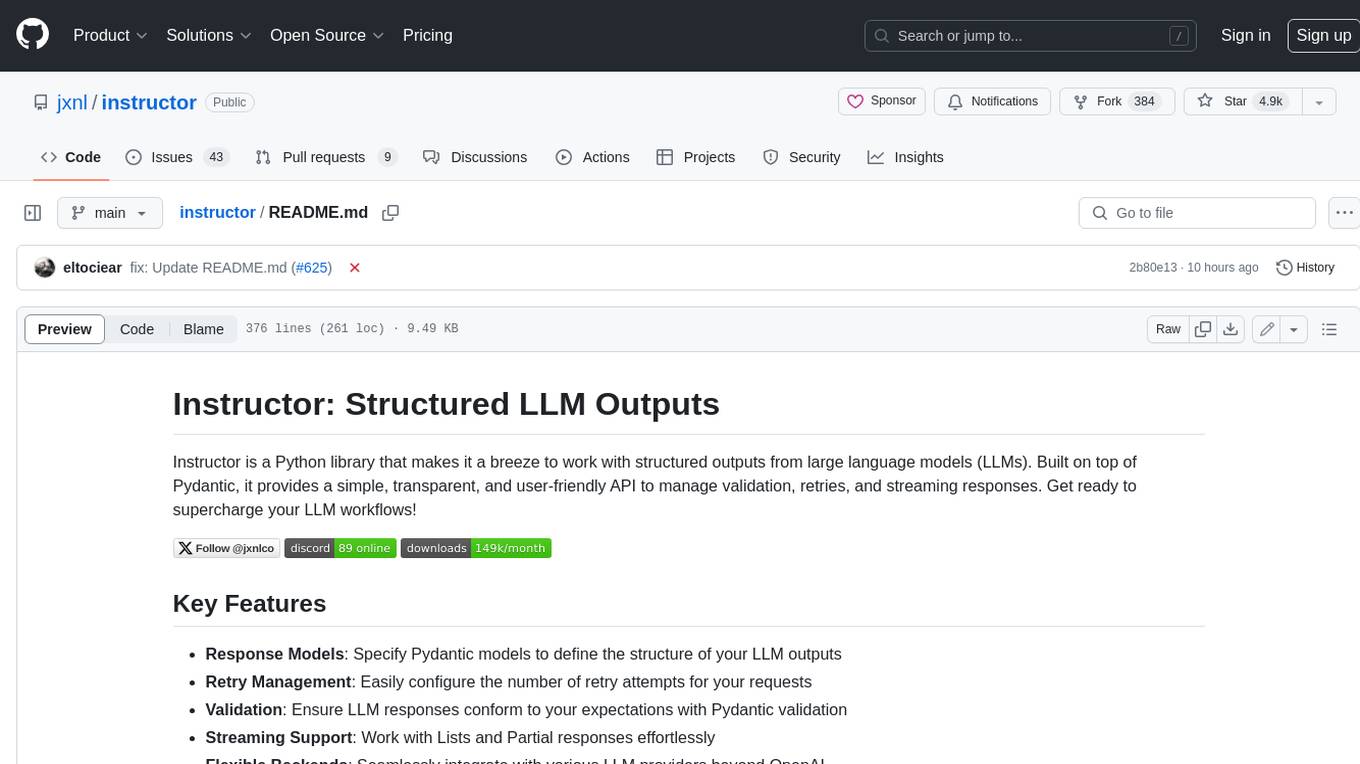
instructor
Instructor is a Python library that makes it a breeze to work with structured outputs from large language models (LLMs). Built on top of Pydantic, it provides a simple, transparent, and user-friendly API to manage validation, retries, and streaming responses. Get ready to supercharge your LLM workflows!

sparrow
Sparrow is an innovative open-source solution for efficient data extraction and processing from various documents and images. It seamlessly handles forms, invoices, receipts, and other unstructured data sources. Sparrow stands out with its modular architecture, offering independent services and pipelines all optimized for robust performance. One of the critical functionalities of Sparrow - pluggable architecture. You can easily integrate and run data extraction pipelines using tools and frameworks like LlamaIndex, Haystack, or Unstructured. Sparrow enables local LLM data extraction pipelines through Ollama or Apple MLX. With Sparrow solution you get API, which helps to process and transform your data into structured output, ready to be integrated with custom workflows. Sparrow Agents - with Sparrow you can build independent LLM agents, and use API to invoke them from your system. **List of available agents:** * **llamaindex** - RAG pipeline with LlamaIndex for PDF processing * **vllamaindex** - RAG pipeline with LLamaIndex multimodal for image processing * **vprocessor** - RAG pipeline with OCR and LlamaIndex for image processing * **haystack** - RAG pipeline with Haystack for PDF processing * **fcall** - Function call pipeline * **unstructured-light** - RAG pipeline with Unstructured and LangChain, supports PDF and image processing * **unstructured** - RAG pipeline with Weaviate vector DB query, Unstructured and LangChain, supports PDF and image processing * **instructor** - RAG pipeline with Unstructured and Instructor libraries, supports PDF and image processing. Works great for JSON response generation

Open-DocLLM
Open-DocLLM is an open-source project that addresses data extraction and processing challenges using OCR and LLM technologies. It consists of two main layers: OCR for reading document content and LLM for extracting specific content in a structured manner. The project offers a larger context window size compared to JP Morgan's DocLLM and integrates tools like Tesseract OCR and Mistral for efficient data analysis. Users can run the models on-premises using LLM studio or Ollama, and the project includes a FastAPI app for testing purposes.
For similar jobs
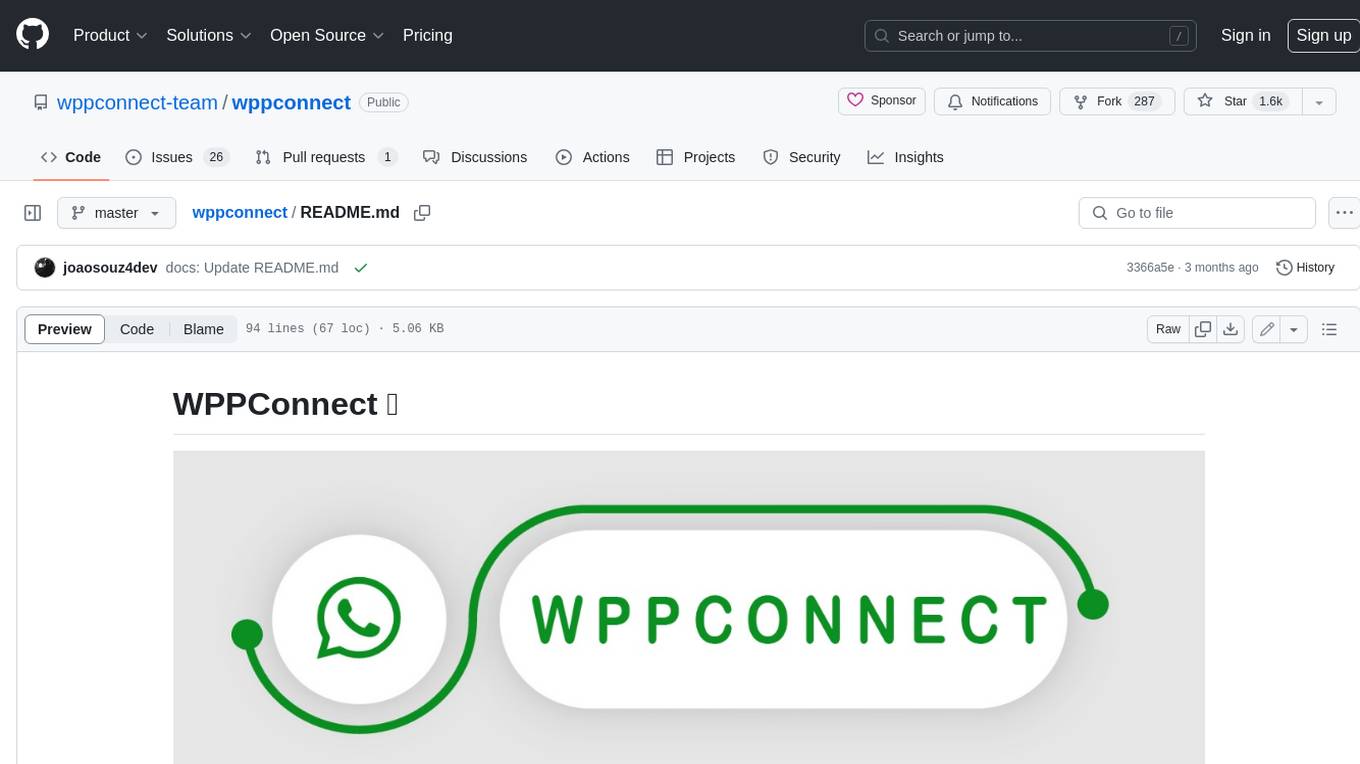
wppconnect
WPPConnect is an open source project developed by the JavaScript community with the aim of exporting functions from WhatsApp Web to the node, which can be used to support the creation of any interaction, such as customer service, media sending, intelligence recognition based on phrases artificial and many other things.

SalesGPT
SalesGPT is an open-source AI agent designed for sales, utilizing context-awareness and LLMs to work across various communication channels like voice, email, and texting. It aims to enhance sales conversations by understanding the stage of the conversation and providing tools like product knowledge base to reduce errors. The agent can autonomously generate payment links, handle objections, and close sales. It also offers features like automated email communication, meeting scheduling, and integration with various LLMs for customization. SalesGPT is optimized for low latency in voice channels and ensures human supervision where necessary. The tool provides enterprise-grade security and supports LangSmith tracing for monitoring and evaluation of intelligent agents built on LLM frameworks.

linkedin-api
The Linkedin API for Python allows users to programmatically search profiles, send messages, and find jobs using a regular Linkedin user account. It does not require 'official' API access, just a valid Linkedin account. However, it is important to note that this library is not officially supported by LinkedIn and using it may violate LinkedIn's Terms of Service. Users can authenticate using any Linkedin account credentials and access features like getting profiles, profile contact info, and connections. The library also provides commercial alternatives for extracting data, scraping public profiles, and accessing a full LinkedIn API. It is not endorsed or supported by LinkedIn and is intended for educational purposes and personal use only.
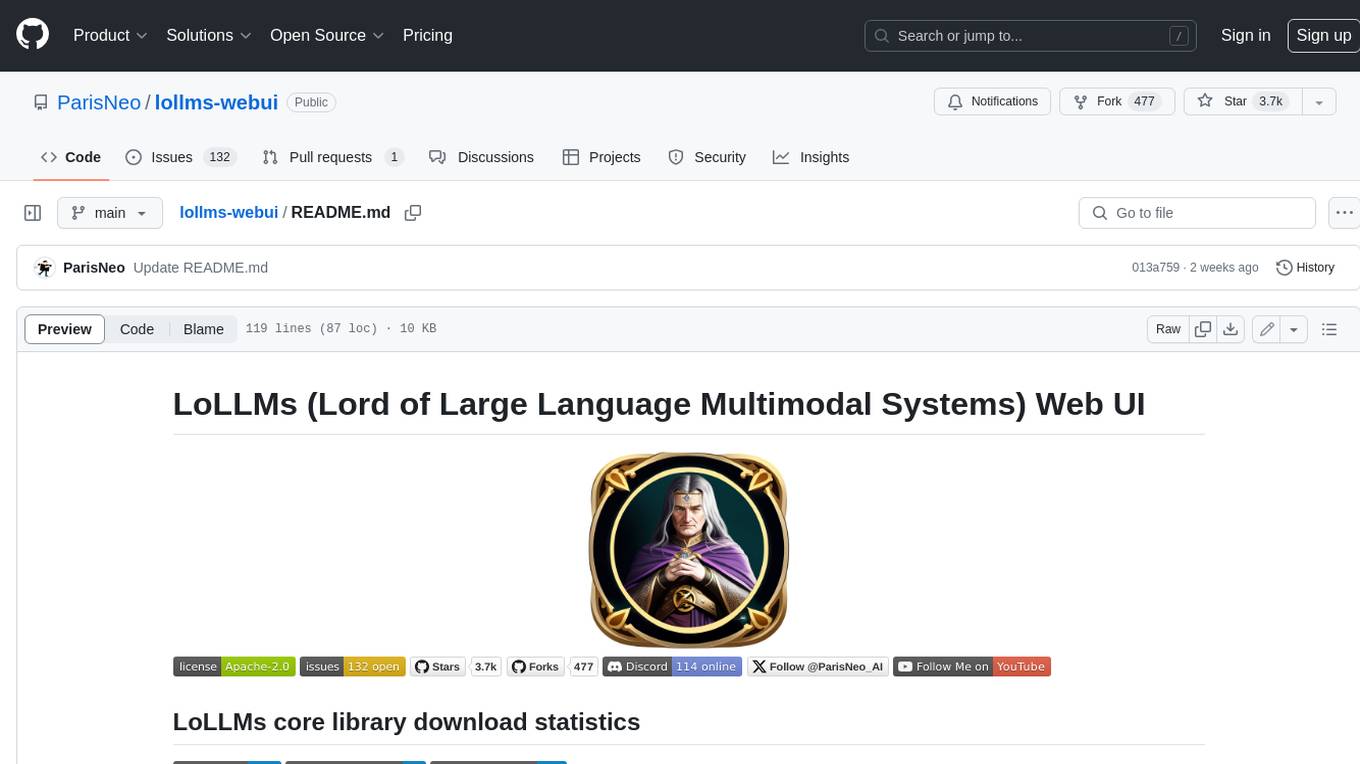
lollms-webui
LoLLMs WebUI (Lord of Large Language Multimodal Systems: One tool to rule them all) is a user-friendly interface to access and utilize various LLM (Large Language Models) and other AI models for a wide range of tasks. With over 500 AI expert conditionings across diverse domains and more than 2500 fine tuned models over multiple domains, LoLLMs WebUI provides an immediate resource for any problem, from car repair to coding assistance, legal matters, medical diagnosis, entertainment, and more. The easy-to-use UI with light and dark mode options, integration with GitHub repository, support for different personalities, and features like thumb up/down rating, copy, edit, and remove messages, local database storage, search, export, and delete multiple discussions, make LoLLMs WebUI a powerful and versatile tool.

Azure-Analytics-and-AI-Engagement
The Azure-Analytics-and-AI-Engagement repository provides packaged Industry Scenario DREAM Demos with ARM templates (Containing a demo web application, Power BI reports, Synapse resources, AML Notebooks etc.) that can be deployed in a customer’s subscription using the CAPE tool within a matter of few hours. Partners can also deploy DREAM Demos in their own subscriptions using DPoC.

minio
MinIO is a High Performance Object Storage released under GNU Affero General Public License v3.0. It is API compatible with Amazon S3 cloud storage service. Use MinIO to build high performance infrastructure for machine learning, analytics and application data workloads.

mage-ai
Mage is an open-source data pipeline tool for transforming and integrating data. It offers an easy developer experience, engineering best practices built-in, and data as a first-class citizen. Mage makes it easy to build, preview, and launch data pipelines, and provides observability and scaling capabilities. It supports data integrations, streaming pipelines, and dbt integration.
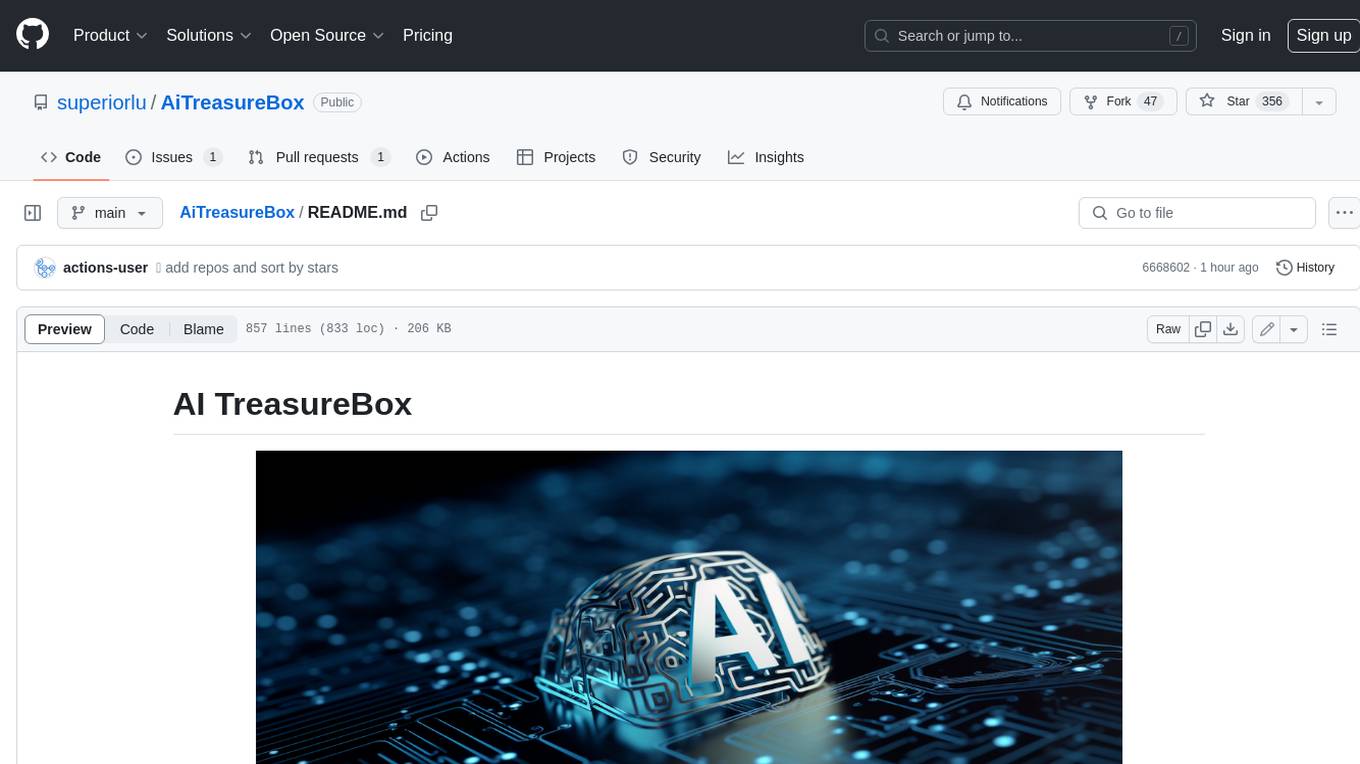
AiTreasureBox
AiTreasureBox is a versatile AI tool that provides a collection of pre-trained models and algorithms for various machine learning tasks. It simplifies the process of implementing AI solutions by offering ready-to-use components that can be easily integrated into projects. With AiTreasureBox, users can quickly prototype and deploy AI applications without the need for extensive knowledge in machine learning or deep learning. The tool covers a wide range of tasks such as image classification, text generation, sentiment analysis, object detection, and more. It is designed to be user-friendly and accessible to both beginners and experienced developers, making AI development more efficient and accessible to a wider audience.









